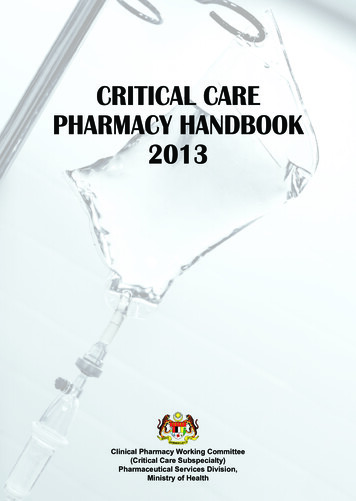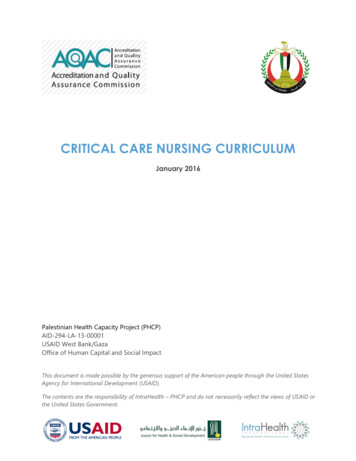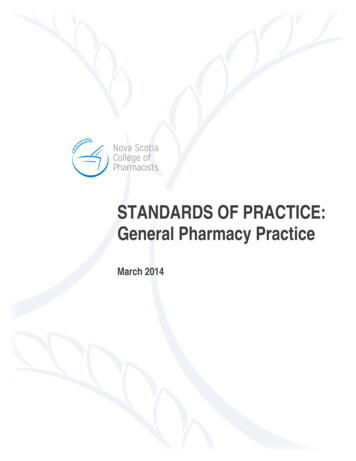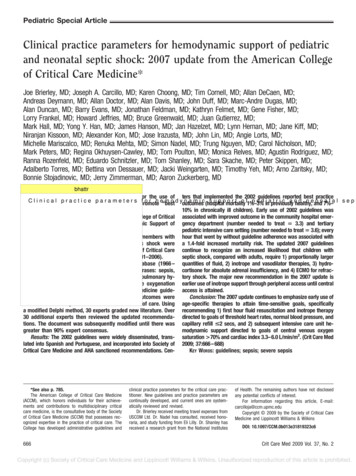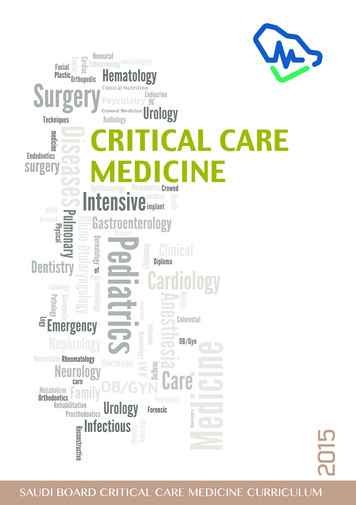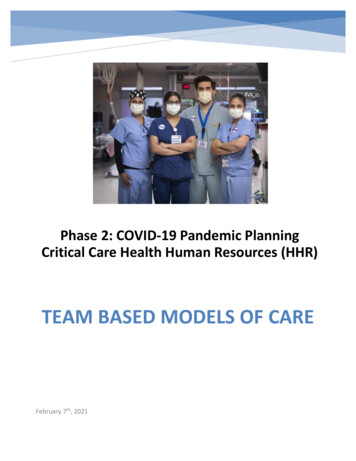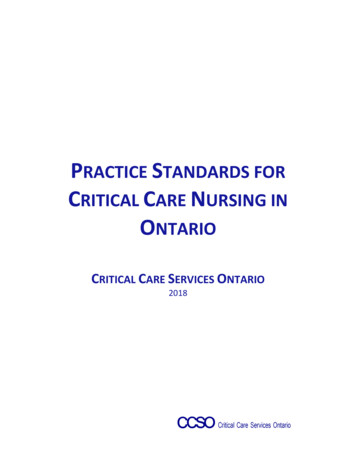
Transcription
PRACTICE STANDARDS FORCRITICAL CARE NURSING INONTARIOCRITICAL CARE SERVICES ONTARIO2018
For information regarding the Practice Standards for Critical Care Nursing in Ontario, please contact:Critical Care Services Ontarioinfo@ccso.caPhone: 1-416-340-4800 ext. 8428 or ext. 5577Critical Care Services Ontario is funded by the Government of OntarioPage 1
TABLE OF CONTENTSIntroduction3Critical Care Nursing Standards Categories and Competency Statements5Professional Behaviour/Ethics6Continuing Competence and Research7Client and Nurse Safety/Risk Prevention9Therapeutic and Professional Relationships/Caring11Therapeutic and Professional Relationships/Caring (continues)12Clinical Skills, Knowledge, Integration and Critical Thinking13Appendix A: Terminology18Appendix B20Appendix C21References22Page 2
IntroductionCritical care nurses provide specialized care to patients experiencing a life threatening or potentially life threateningillness. This care is complex, intensive and continuous. The intensity of the patient care requirements differs betweenlevel 2 and level 3 critical care units as it is based on the patients’ illness trajectory. As a result, the level of complexityof nursing skills required for nurses in level 2 units may differ with more invasive skills required of nurses in level 3critical care units. Regardless of the type of unit, nursing attributes required to practice critical care nursing includeadvanced theoretical knowledge, critical thinking, advanced problem solving, responsible leadership, advocacy,judgment and sound communication skills. To support the nurse in this practice requires a supportive and safeworking culture provided through strong leadership of the health care facility and critical care unit.Quality critical care nursing practice requires the engagement and interconnection of three elements: the healthcare facility, the critical care unit, and the critical care nurse. The health care facility, creates the necessary safetyculture and quality environment that provides the foundation for the nursing practice. Supported by the LocalHealth Integration Network (LHIN) Critical Care Network [LCCN] and Critical Care Services Ontario (CCSO), thehealth care facility drives quality and performance improvement though their accountability mechanisms andcritical care quality framework. The critical care unit, incorporates the quality care framework within its policiesand processes such as the use of high performance check lists and closely monitors the program score cards;thereby providing oversight mechanisms to create conditions for daily quality care supported by evidenceinformed practices which supports the clinical nurse in achieving best practice. The critical care nurse, by utilizingspecific knowledge and building on previous experience, progresses along the continuum from novice to expertcritical care nurse. The critical care nurse maintains professional competence through ongoing learning andreflective practice. In addition, the critical care nurse contributes positively to the image of nursing and iscommitted to the delivery of quality patient care. In order to foster delivery of evidence-based and/or bestpractices within critical care nursing, defining competency is crucial.The Standards for Critical Care Nursing in Ontario (2012) were developed to identify desirable and achievable criticalcare nursing knowledge and competencies with the intent to standardize critical care nursing practice within theprovince of Ontario. The Standards for Critical Care Nursing in Ontario (2012) are based on the 2009 Standards ofNursing Practice of the College of Nurses of Ontario (CNO) and the revised 2017 Canadian Association of Critical CareNurses (CACCN).The 2018 release of the Practice Standards for Critical Care Nursing in Ontario replaces the second edition in 2012.It reflects the Excellent Care for All Act1 (ECFAA) legislation, ensuring critical care nursing practice includes a focuson inter-professional and multidisciplinary practice, and patient and family-centred care. (Note: Family is who thepatient identifies as their family. See Appendix A). This edition provides further clarity on the supportingrequirements of a health care facility and critical care unit which facilitate the achievement of Critical Care NursingPractice Standards by each nurse working within a critical care environment.The Practice Standards for Critical Care Nursing in Ontario are organized into the following categories: Professional Behaviour/Ethics1On June 8, 2010, the Excellent Care for All Act, 2010 (ECFAA) received Royal Assent and most requirements in the Act came into force. The Actrequires health care organizations, beginning with public hospitals, to : Develop and post annual quality improvement plans Implement patient and employee satisfaction surveys and a patient relations process Link executive compensation to achievement of quality plan performance improvement targets Develop declarations of values after public consultation Create quality committees to report to each hospital board on quality related issuesSource: tion/ecfa notice.aspxPage 3
Continuing Competence and ResearchClient and Nurse Safety/Risk PreventionTherapeutic and Professional Relationships/CaringClinical Skills, Knowledge, Integration and Critical ThinkingEach category consists of competency statements and the associated criteria or performance behaviours related tothe three elements (organization, unit and/or nurse). The criteria have been adapted from the CACCN Standards forCritical Care Nursing Practice. The CACCN Structure of the Critical Care Unit is also incorporated to identify the keyinfrastructure necessary to support critical care nursing practice in the province of Ontario.The Practice Standards for Critical Care Nursing in Ontario is intended for use by critical care nurses, critical care unitmanagers, and program administrators in critical care units across the province. As previously noted, the level ofcomplexity in nursing skill requirements is based on patient illness trajectory which is also reflected in the type ofunit (level 2 or 3) which houses the patient. Competencies and criterion in which intensity of nursing skills may varyhave been identified by an asterisk (*).The Practice Standards for Critical Care Nursing in Ontario will be reviewed bi-annually and edited, if required, tomaintain quality and relevance.Page 4
Critical Care Nursing Standards Categories and Competency StatementsPROFESSIONAL BEHAVIOUR/ETHICSCompetency Statement1. The critical care nurse practices within the scope of professional, legal and ethical standards.CONTINUING COMPETENCE AND RESEARCHCompetency Statements2. Personnel assigned roles and responsibilities within the critical care unit (related to the structure of thecritical care unit) are qualified and current in practice.3. A mechanism for communication and establishment of policy/procedures such as a Critical CareCommittee is established and endorsed by the health care facility in collaboration with the critical careteam (related to the structure of the critical care unit).4. The critical care nurse has a shared accountability along with the unit and organization to seek out andobtain education to maintain, enhance and improve his/her practice.CLIENT AND NURSE SAFETY/RISK PREVENTIONCompetency Statements5. The health care facility has a quality and safe work environment.6. The critical care nurse in collaboration with other members of the interdisciplinary health care teamformulates the plan of care.7. The health care facility provides opportunities for the critical care nurse to maintain the knowledge andskills necessary to deliver safe and knowledgeable care within the context of the chosen conceptualmodel of nursing practice.THERAPEUTIC AND PROFESSIONAL RELATIONSHIPS/CARINGCompetency Statements8. Based upon knowledge of nursing, biological, physical, psycho-social and behavioural sciences, data arecontinuously analyzed by the critical care nurse to: identify patient and/or family wishes, priorities andproblems; formulate a care plan, and provide interventions which are evidence-based, in collaborationwith other members of the interdisciplinary health care team and patient/family.9. The critical care nurse implements the plan of care including independent and interdependent nursingfunctions.10. The critical care nurse evaluates patient outcomes in accordance with a conceptual model for critical carenursing and consistent with independent nursing functions.CLINICAL SKILLS, KNOWLEDGE, INTEGRATION AND CRITICAL THINKINGCompetency Statements11. The critical care nurse continuously assesses, monitors and evaluates data regarding the patient’sphysical, emotional, and psycho-social status. In addition, documentation regarding advance directives iscollected by the critical care nurse at the time of admission and throughout the patient’s stay.12. Based upon knowledge of nursing, biological, physical, psycho-social and behavioural sciences, data arecontinuously analyzed by the critical care nurse to formulate nursing response and interventions based onpatient and/or family wishes, priorities, problems and needs.13. Interventions based upon the patient and/or family wishes, priorities and problems are planned by thecritical care nurse, in collaboration with other members of the inter-professional health care team toformulate the overall plan of care.14. The critical care nurse in collaboration with the inter-professional health care team and patient/familyimplements the plan of care using advanced skills and knowledge within his/her professional scope ofpractice to promote quality of care, safety initiatives and best practice.*15. The critical care nurse evaluates patient outcomes in accordance with a conceptual model for critical carenursing and consistent with independent and interdependent nursing functions.Page 5
Professional Behaviour/EthicsCompetency Statement1. The critical care nurse practices within the scope of professional, legal and ethical standards.CriterionThe health care facility:1.1 Complies with all appropriate legislation and in collaboration with the Local Health Integration Network(LHIN) Critical Care Network [LCCN] strives to achieve CCSO Critical Care Strategic Goals.The critical care unit:1.2 Monitors, evaluates and reports unit-based performance data and participates in improvement activitiesrelated to Quality Improvement Plans and ECFAA.1.3 Ensures unit staff and physicians are aware of performance data and are engaged in determiningimprovement activities.The critical care nurse:1.4 Incorporates professional, legal, ethical and critical care standards into practice.1.5 Practices patient and family-centred care, and is focused on engaging patients and families in the careprocess1.6 Ensures patient and family privacy and confidentiality within the limits of the environment1.7 Participates in building a culture of safety by identifying and proactively reporting near misses andreporting errors, omissions, and incidents promptly as well as participating in disclosure and support tofamily and colleagues1.8 Follows guidelines for reporting data to appropriate agencies (e.g. Critical Care Information System, Officeof the Chief Coroner)1.9 Identifies potential organ and tissue donors through adherence to Trillium Gift of Life Network 2- End ofLife Care guidelines and legislation1.10 Responds in a timely manner to environmental, physical, and psychosocial stress factors which impactinter-professional team members in the critical care setting1.11 Participates in critical care nursing research and incorporates research findings into practice whereapplicable1.12 Recognizes the delineation between the practice of critical care nursing and the practice of critical caremedicine1.13 Develops and maintains professional relationships focusing on working with others in a positive and nonthreatening manner1.14 Develops and maintains professional relationships by conducting themselves in a way that promotesrespect for team members and contributes to positive team functioning2Trillium Gift of Life Network was created in December 2000 by the Ontario Government and assumed the role of Ontario's central organ andtissue donation agency with the challenge to significantly increase organ and tissue donation across the province and improve related processesand functions. Source: www.giftoflife.on.caPage 6
Continuing Competence and ResearchCompetency Statement2. Personnel assigned roles and responsibilities within the critical care unit (related to the structure of thecritical care unit) are qualified and current in practice.CriterionThe health care facility:2.1 Provides the structure and materials to ensure that research is feasible and ethical.2.2 Ensures there are hiring practice policies and procedures to ensure qualified individuals are recruited andhired.2.3 Ensure all employees receive an orientation to the assigned clinical area which reflects facility-widerequirements as well as unit specific needs.The critical care unit:2.4 Staff Nurses, with advanced preparation, education or experience in critical care nursing are responsiblefor direct patient and family-centred care.2.5 Ensures that patient assignments are based on skills, knowledge, and ability of the critical care nurse andthe patient’s needs and acuity2.6 Ensures that all critical care nursing personnel receive a performance appraisal, in accordance with thehospital’s policies, which is based on the written job description, discussed with the staff membersinvolved, and includes a process for the development of mutually agreed upon goals and objectivesThe critical care nurse:2.7 Stays current with evidence informed practice changes on the unit and identifies and reports tosupervisor if further skill development required.2.8 Attends inservices and/or education to maintain clinical competency.2.9 Promotes research, evidence-informed practice, and dissemination of best practice.2.10 Provides leadership to other members of the critical care team by acting as a resource person & mentor.Competency Statement3. A mechanism for communication and establishment of policy/procedures such as a Critical CareCommittee is established and endorsed by the health care facility in collaboration with the critical careteam (related to the structure of the critical care unit).CriterionThe Critical Care Unit:3.1 Ensures the method of communication has broad representation from all levels of critical care nursing,medicine, and allied health care professionals involved in patient care and, if possible, patient/familyadvisors3.2 Administration works in collaboration with those represented in 3.1 in an advisory or decision-makingcapacity with responsibilities for, but not limited to: Unit philosophy, goals, and objectives Structural planning Policies and procedures Program development and evaluation Establishment of a mechanism for resolving issues related to interdepartmental andinterdisciplinary matters, and insufficient resources Unit quality improvement activities, ensuring alignment with Quality Improvement Plan andAccreditation Canada StandardsPage 7
Accountable for improvement on all indicators, including publically reported outcomesMechanisms and methods to analyze, plan and take action on statistical data, related utilizationand outcomes Other activities as deemed appropriate in an organizational setting3.3 Endorses written information regarding the critical care unit including, but not limited to: Unit philosophy, goals, and objectives Organization chart Dependent nursing responsibilities Medical responsibilities Roles and responsibilities of other health professionals in the unit3.4 Endorses written policies and procedures specific to the critical care unit including, but not limited to: Admission, transfer, and discharge criteria Surge Capacity Management Plan Fire, disaster, and evacuation Medication administration and other treatments Transfer of medical function(s) and shared competencies Protocols for management of specific patient populationsCompetency Statement4. There is shared accountability of the critical care nurse along with the unit and organization to seek outand obtain education to maintain, enhance and improve his/her practice.CriterionThe critical care unit:4.1 Will regularly provide opportunities for nursing education and practice of rarely used critical care skills onan annual basis.4.2 Will provide educational opportunity for any new skill required in the critical care unit.The critical care nurse:4.3 Will seek opportunities to continually learn issues around critical care to enhance knowledge, skills andcompetenciesPage 8
Client and Nurse Safety/Risk PreventionCompetency Statement5. The health care facility has a quality and safe work environment.CriterionThe health care facility and critical care unit:5.1 Have defined, transparent processes for timely reporting and responding to concerns from all employeesand patients/families, unusual occurrences, errors and near misses.5.2 Engages patients/families is decision making that can influence or impact patient care such as PatientAdvisory Councils, patient/family representation on committees.5.3 Implements and adheres to Required Organization Practices and Accreditation Canada Standards and theOccupational Health and Safety Act (2017).The critical care nurse:5.4 Contributes to the development of a culture of safety within the critical care environment by ensuring anysafety concerns are brought forward to a supervisor in a timely manner.5.5 Will ensure self-safety by utilizing appropriate Personal Protection Equipment as per hospital/unit policyand protocols.5.6 Will follow and comply with any hand-washing expectations as per infection control practices.Competency Statement6. The critical care nurse in collaboration with other members of the interdisciplinary health care teamformulates the plan of care.CriterionThe critical care nurse:6.1 Formulates the plan of care in a culture of quality, safety, and risk prevention6.2 Practices with an inter-professional team and actively engages in implementation of evidence basedand/or best practice in relation to clinical care and patient safety for patients, family, and members of thehealth care team when developing the plan of care.6.3 Monitors and evaluates results of the clinical plan of care, then, according to evidence and in discussionwith the team, makes revisions in the plan accordingly.Competency Statement7. The health care facility provides opportunities for the critical care nurse to maintain the knowledge andskills necessary to deliver safe and knowledgeable care within the context of the chosen conceptualmodel of nursing practice.CriterionThe critical care unit:7.1 Develops criteria for hiring nurses based on the knowledge and skill requirements of the job7.2 Provides an orientation program which: Is based on a learning needs assessment Includes specific unit philosophy, goals, policies and procedures, as well as an organizationalchart for the unit Includes physical layout and instructions on the use of unit equipment Includes a clinical and theoretical component, the content and length of which is based on thelevel and type of unitPage 9
7.3 Provides continuing education and communication on the following: New or revised policies and procedures The use of new or updated equipment Advanced skills or skills used infrequently (i.e. Intra-aortic balloon pump, ContinuousRenal Replacement Therapy) Roles and responsibilities of the critical care nurse, including the role of charge nurse, preceptor,as well as other members of the interprofessional team Role of the critical care nurse on the health care team Theory pertinent to the critical care patient population and the learning needs of critical carenurses Critical incident stress management for all staff members The use and fitting of personal protective equipment for all staff involved in patient care7.4 Evaluates the knowledge and competencies of the critical care nurse on an ongoing basis7.5 Ensures the availability of current evidence and literature relevant to the patient populationThe critical care nurse:7.6 Takes advantage of and attends educational opportunities to enhance clinical skills and theoreticalknowledge.7.7 Ensures self-competence in all skills performed. Self-identifies issues with competency and informssupervisor if update is required.7.8 Stays current on any unit policy or procedural changes.P a g e 10
Therapeutic and Professional Relationships/CaringCompetency Statement8. Based upon knowledge of nursing, biological, physical, psycho-social and behavioural sciences, data arecontinuously analyzed by the critical care nurse to: identify patient and/or family wishes, priorities andproblems; formulate a care plan, and provide interventions which are evidence-based, in collaborationwith other members of the interdisciplinary health care team and patient/family.CriterionThe critical care nurse:8.1 Addresses significant findings with other members of the inter-professional team, patients, familiesand/or Substitute Decision Makers3 (SDMs)8.2 Collaborates with patient, family, and other health care team members to establish an individualized andholistic plan of careCompetency Statement9. The critical care nurse implements the plan of care including independent and interdependent nursingfunctions.CriterionThe critical care nurse:9.1 Optimizes communication with the patient and family by: Assessing current communication status by using all techniques available and involving the familyin interpreting the patient’s efforts to communicate (e.g. lip reading, gestures, posturing, eyecontact, touch) Encouraging and teaching the family and other members of the inter-professional health careteam strategies to communicate with the patient Continuously evaluating the effectiveness of the communication process9.2 Intervenes to facilitate optimal family processes by: Using language that is consistent with level of understanding, education, culture andcircumstance of the patient Providing an opportunity for the patient/family to verbalize feelings and concerns, usinginterpreters when needed Demonstrating concern and acceptance through sincere and empathetic verbal and nonverbalcommunication Providing honest and realistic information to the patient/family Providing ongoing support Providing frequent and regular exchanges of information Using principles of crisis intervention to identify and mediate source of crisis Initiating internal/external referrals Providing opportunity and privacy for patient/family interaction Facilitating partnerships and decision-making with family members Involving the family in direct patient care Encouraging and exploring the verbalization of feelings Providing opportunities to make informed choices Educating the patient and family about nursing and collaborative interventions based on learningneeds3According to the Health Consent Act, ‘substitute decision-maker’ refers to a person who is authorized under section 20 to give or refuse consentto a treatment on behalf of a person who is incapable with respect to the treatment. 1996, c. 2, Sched. A, s. 9.Source: elaws statutes 92s30 e.htmP a g e 11
Therapeutic and Professional Relationships/Caring (continues)Competency Statement10. The critical care nurse evaluates patient outcomes in accordance with a conceptual model for critical carenursing and consistent with independent nursing functions.CriterionThe critical care nurse:10.1 Reports, discusses, and addresses significant differences between actual and expected outcomes with theappropriate inter-professional team members in order to modify the plan of careP a g e 12
Clinical Skills, Knowledge, Integration and Critical ThinkingCompetency Statement11. The critical care nurse continuously assesses, monitors and evaluates data regarding the patient’sphysical, emotional, and psycho-social status. In addition, documentation regarding advance directives iscollected by the critical care nurse at the time of admission and throughout the patient’s stay.CriterionThe critical care nurse:11.1 Reports, discusses, and addresses significant differences between actual and expected outcomes with theappropriate inter-professional team members in order to modify the plan of care at patient’s transition points;including but not limited to: Time of admission to the unit Beginning of each shift Change of patient assignment Change in patient’s clinical status When providing handover of care upon transfer11.2 Assesses, interprets, and evaluates data on a continual basis, based on comprehensive physiologicalassessment, laboratory and diagnostic data, as well as interactions from the patient and family as needed and: Using technological supports both invasive and non-invasive (See Appendix B)11.3 Collects laboratory specimens as per hospital policy (e.g. sputum via endotracheal tube, blood viainvasive lines)11.4 Continuously gathers pathophysiological, psycho-social, cultural, developmental, spiritual and family’sneeds data based on the patient’s condition11.5 Obtains a comprehensive health history using all available and appropriate sources in the absence ofpatient’s ability to communicate11.6 Assesses data regarding infection control and transmission risks to patients and staff and takes all thenecessary measures to prevent risk in a proactive manner by ensuring adherence to routine practicesCompetency Statement12. Based upon knowledge of nursing, biological, physical, psycho-social and behavioural sciences, data arecontinuously analyzed by the critical care nurse to formulate nursing response and interventions based onpatient and/or family wishes, priorities, problems and needs.CriterionThe critical care nurse:12.1 Analyzes unexpected findings and makes rapid decisions about priorities of care12.2 Anticipates, intervenes and delivers measures to manage multi-organ and single system organ failure, aswell as provides best evidence care to prevent complications and promote optimal health; including but notlimited to: Ineffective airway clearance Respiratory failure secondary to impaired gas exchange, mechanical failure, respiratory musclefatigue, inflammation, infection, inhalation injury, obstruction or trauma Shock and/or hypotension due to arrhythmias, and/or pump failure, obstruction, infection orinflammation Alteration in cardiac output either due to mechanical or electrical dysfunction Brain injury, head trauma, cerebral aneurysm, seizures, meningitis, neurogenic shock, cerebralvascular accident, arteriovenous malformation, cerebral vasospasm, and increased intracranialpressure Gastrointestinal tract abnormalities due to organ failure, bleeding, infection, inflammation ortrauma Acute renal failure with fluid, electrolyte, or acid-base imbalanceP a g e 13
Vascular tissue perfusion abnormalitiesSkin breakdown, loss of skin integrity due to thermal injury, trauma, infection of exfoliativediseases Abnormality in fluid balance Ineffective thermoregulation Alterations in musculoskeletal function Alterations in endocrine function Alterations in immunologic function Alterations in hematologic function Abnormality in mood, judgment, or cognition including anxiety Delirium, depression and dementia Impaired communication Altered family processes Altered family/patient coping Manifestations of abuse (e.g. child, spouse, elder) Altered nutritional requirements End-of-Life Care Transition to allow for a natural death Pain12.3 Interprets, evaluates, and responds to pertinent diagnostic data in a timely and appropriate manner (SeeAppendix C)Competency Statement13. Interventions based upon patient and/or family wishes, priorities and problems are planned by the criticalcare nurse, in collaboration with other members of the inter-professional health care team to formulatethe overall plan of care.CriterionThe critical care nurse:13.1 Anticipates and prepares for life-threatening situations13.2 Establishes priorities for care with the patient/family13.3 Selects specific nursing interventions designed to achieve expected patient outcomes13.4 Balances the science of curing with the art of caring13.5 Incorporates the patient’s pathophysiological, psycho-social, cultural, spiritual, and developmental needs,into the plan of care13.6 Formulates measurable immediate and longer-term, patient-oriented goals with the patient and/orfamily and health care team13.7 Identifies realistic and measurable expected patient outcomes to be used in the evaluation offormulated goals13.8 Validates the plan of care with the patient, family and other members of the health care team13.9 Identifies required resources to accomplish the plan of care13.10 Documents and revises the plan of care as necessary13.11 Identifies patient and family learning needs when formulating the plan of care13.12 Plans for patient and family support needs13.13 Identifies and plans for transition and direction of careP a g e 14
Competency Statement14. *The critical care nurse in collaboration with the inter-professional health care team and patient/familyimplements the plan of care using advanced skills and knowledge within his/her professional scope ofpractice to promote quality of care, safety initiatives and best practice.CriterionThe critical care nurse:14.1 *Implements care that reflects established priorities and evidence based practice (e.g. Central LineInfections and Ventilator Associated Pneumonia bundles, early mobilization and nutrition)14.2 Ensures timely and accurate documentation in the patient health record in accordance with hospitalpolicies and CNO standards14.3 Communicates sign
practices within critical care nursing, defining competency is crucial. The Standards for Critical Care Nursing in Ontario (2012) were developed to identify desirable and achievable critical care nursing knowledge and competencies with the intent to standardize critical care



